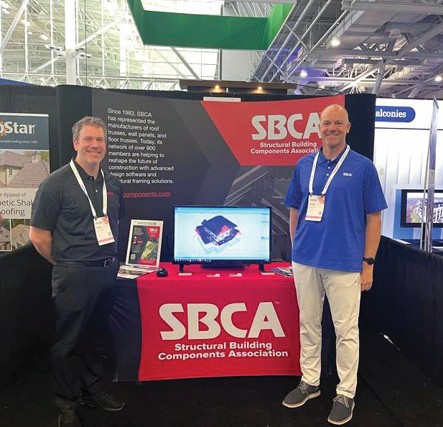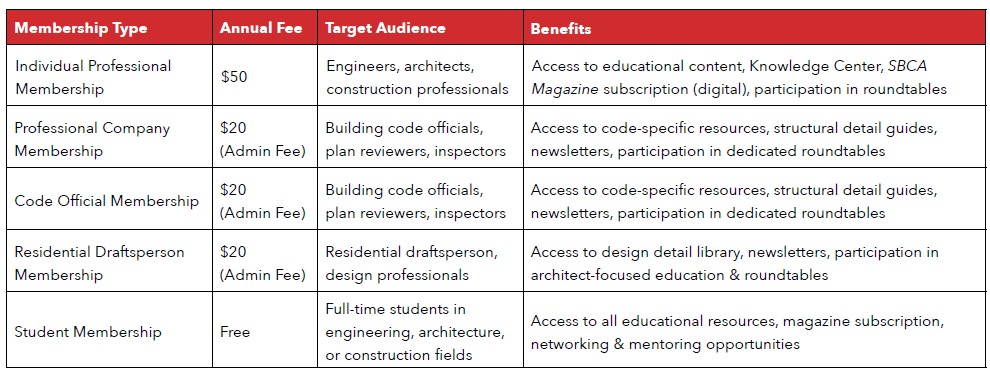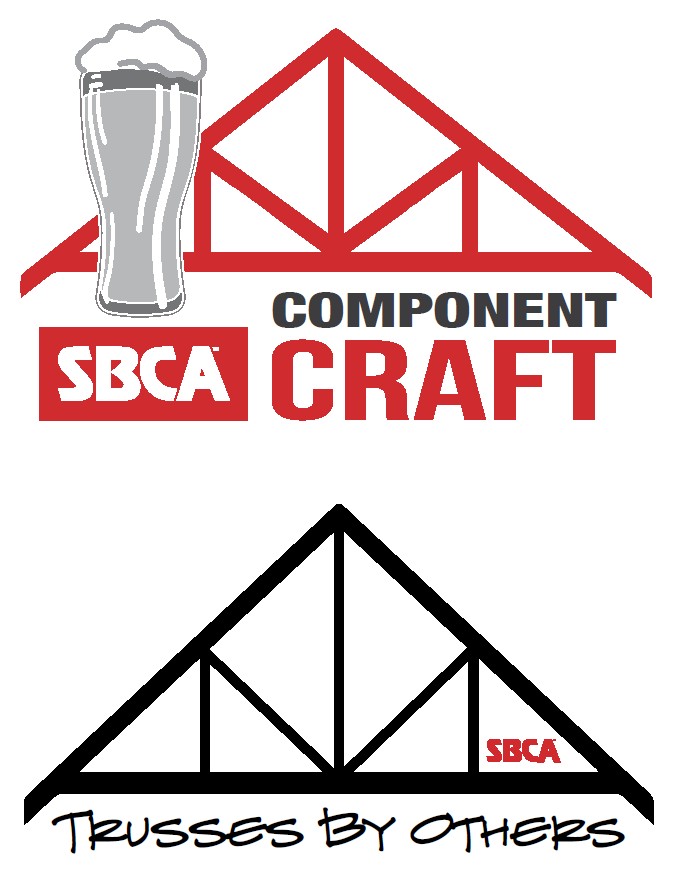Building Bridges and Broadening the Industry’s Impact
A Strategic Approach to Connect, Engage, and Evolve
By Sean D. Shields and Abby Langenberg
The Structural Building Components Association (SBCA) has long been recognized for fostering strong communication and collaboration within the component manufacturing industry. Through resources like BCSI, Jobsite Packages, SBCA Magazine, and the annual Building Component Manufacturers Conference (BCMC), the association has created a tight-knit community committed to innovation, peer-learning, and continuous improvement.
 Yet, as construction continues to evolve and become more complex, the future growth of SBCA and its members’ influence is impacted by forging new relationships beyond core functions will be vital to future industry growth. The industry needs to expand its sphere of influence to include professionals who design, inspect, and influence the structural framework of buildings into which components are integrated. And while this initiative will naturally help grow SBCA’s reach, the main goal of SBCA’s Professional Membership is to equip those creating building plans with the knowledge and resources they need to confidently design with components, such as roof trusses, floor trusses, and wall panels, as the primary structural solution from the outset.
Yet, as construction continues to evolve and become more complex, the future growth of SBCA and its members’ influence is impacted by forging new relationships beyond core functions will be vital to future industry growth. The industry needs to expand its sphere of influence to include professionals who design, inspect, and influence the structural framework of buildings into which components are integrated. And while this initiative will naturally help grow SBCA’s reach, the main goal of SBCA’s Professional Membership is to equip those creating building plans with the knowledge and resources they need to confidently design with components, such as roof trusses, floor trusses, and wall panels, as the primary structural solution from the outset.
SBCA has reimagined its Professional Membership category to better engage architects, engineers, draftspeople, code officials, and students. These are professionals whose daily decisions shape the use, and specification, of structural components. This evolution is more than a membership restructuring; it’s essentially a strategic move to bridge a critical gap that currently exists in our industry, and forge lasting partnerships across more of the construction supply chain.
Building Designers are Key to Industry Growth
Building designers (see page 39) play a pivotal role in determining how structural elements are utilized in residential and commercial projects. Whether it’s developing the initial design concept, modeling load paths, or detailing individual structural connections, these professionals ultimately shape the structural framework of the building and influence whether structural components like trusses and wall panels will be utilized.
In this way, designers can often act as inadvertent gatekeepers to the use of components in each project. Their understanding of truss design responsibilities, load transfer, code compliance, and product capabilities directly affects how (and how often) components are specified. That’s why engaging this group is essential to our industry’s future growth. With education, collaboration, and access to resources, building designers can become powerful advocates for component solutions, helping ensure structural integrity, framing efficiency, and cost-effective methodology across a wider range of construction projects.
SBCA Is Reaching Out to Building Designers
While many building designers operate upstream from component manufacturers (CMs), the value of fostering relationships between these groups is often overlooked, much to the industry’s detriment. Every collaborative interaction between a designer and a CM, whether on layout clarification, engineering support, or jobsite coordination, establishes the groundwork for increased specification of structural components. In order for these relationships to develop in a meaningful way, introductions have to be made, education needs to be provided, and clear lines of collaborative communication must be created.
That’s where SBCA is looking to educate building design professionals and help facilitate relationship building with CM members in order to facilitate successful specification of components on future projects. The association is strategically expanding its reach to serve as the catalyst for those connections, ensuring that designers are not only introduced to the expertise, capacity, and capabilities of CMs, but are also equipped with the technical knowledge, tools, and partnerships necessary to include components more confidently and consistently in their plans.
SBCA Has Restructured Professional Memberships
To formalize and strengthen these connections, SBCA has reimagined its Professional Membership categories in hopes of better meeting the needs of the building design community. The new model simplifies membership levels and clarifies benefits, making it more attractive and accessible for professionals like architects, engineers, code officials, and students to join and engage with SBCA.
Central to this effort is the development of tools and resources tailored specifically to this audience. They include technical publications, on-demand education, design guides, and member directories, all aimed at fostering a better understanding of components and encouraging collaboration. The goal is to provide tangible value and create open lines of communication with the association and individual CM members.
“Building Designer” is a broad term that encompasses several different professions and roles:
Architect: Architects design the overall look of and function of structures. They work to ensure that the final product is both attractive and functional.
Engineer: Engineers manage the operational and maintenance aspects of buildings, ensuring each aspect of the building functions safely, efficiently, and in compliance with regulations.
Draftsperson: Draftspeople, also known as architectural drafters, create technical drawings and plans for buildings and other construction projects, typically with the use of computer-aided design (CAD) software.
Inspector: Building inspectors review and approve building plans and inspect the construction process to ensure construction projects comply with building codes, regulations, and safety standards.
By reshaping the Professional Membership experience, SBCA is creating a more inclusive and collaborative ecosystem, one in which ideas and innovations flow freely between designers and manufacturers for the benefit of the broader construction industry.

SBCA Is Advertising & Exhibiting
To further support this outreach, SBCA is actively engaging with the building designer community (architects, engineers, draftspeople, etc.) where they congregate. Through partnerships with trade organizations like the American Institute of Architects (AIA), the National Council of Structural Engineers Associations (NCSEA), and the International Code Council (ICC), SBCA is exhibiting at key conferences and placing targeted advertisements in trade publications. SBCA is also seeking partnerships with the National Association of Home Builders (NAHB), American Institute of Building Design (AIBD), and other organizations that reach building designers who serve primarily the single-family residential industry.
This grassroots approach introduces the component industry to professionals who may never have interacted with SBCA or its members before. It is a deliberate attempt to raise awareness of component solutions, explain their benefits, and position SBCA as a trusted resource for education and connection to the broader component manufacturing industry. The effort doesn’t solely reside with organizations but will also extend to individuals withing the design community who may not be affiliated with a formal organization.
SBCA is Hosting Regional Events in 2026
Building on this momentum, SBCA is launching a new initiative in 2026 called SBCA Component Craft. This series of regional events is primarily designed to educate, but also connect, construction and building industry professionals with the component manufacturing industry. These in-person events will serve as interactive forums where attendees can learn more about the fundamentals of structural component design and performance, as well as gain a better understanding of the standards and best practices that guide everything from design and manufacturing to the installation of these structural framing products.
 Each event will include topics such as component specification best practices, navigating code compliance, or optimizing framing designs with structural components. The environment will foster direct engagement among CM industry veterans and architects, engineers, and/or code officials, and begin to foster a collaborative approach to the specification of trusses. In essence, it is taking the traditional design approach of “trusses by others,” and giving them a clear path to better understanding and working directly with the “others” on the front end. Ultimately, the goal is for components to be the primary structural solution in mind as building plans are being developed.
Each event will include topics such as component specification best practices, navigating code compliance, or optimizing framing designs with structural components. The environment will foster direct engagement among CM industry veterans and architects, engineers, and/or code officials, and begin to foster a collaborative approach to the specification of trusses. In essence, it is taking the traditional design approach of “trusses by others,” and giving them a clear path to better understanding and working directly with the “others” on the front end. Ultimately, the goal is for components to be the primary structural solution in mind as building plans are being developed.
SBCA Component Craft represents a powerful opportunity to demystify the component manufacturing process, build lasting connections, and bring professionals into the SBCA community with a deeper appreciation of the value components bring to every project. These events will also seek to offer a clear path toward SBCA Professional Membership to further engage attendees beyond each regional event.
SBCA Seeks to Offer Greater Value to CM Members
These initiatives are aimed at expanding SBCA’s reach and influence within the building design community, while also delivering direct benefits to its members. Building collaborative relationships with building design professionals will take time, but the long-term rewards in the form of greater component use, smoother project execution, and fewer field issues are well worth the investment.
The reimagined Professional Membership and the new SBCA Component Craft events aren’t just about creating opportunities for future growth; they’re also about ensuring greater alignment through the construction supply chain. They ensure that CMs and their Associate partners are better connected to the people who impact their work most, namely designers, engineers, and code officials.
Added benefits for SBCA members include:
- Direct engagement with the professionals who specify and inspect their products.
- Improved communication that leads to clearer expectations, fewer revisions, and more efficient jobsite collaboration, as well as improved feedback loops between CMs and the building designers.
- An educated stakeholder network that understands the structural value and application of trusses, wall panels, and other components.
- Increased visibility among potential partners, which opens doors for new business opportunities.
- More projects that include “Trusses by Others”—a tangible indicator that components are being specified from the outset.
SBCA Is Increasing Membership Engagement Efforts
SBCA is also doubling down on engagement with both new and existing regular members. Whether through technical resources, networking, or education, the association is committed to enhancing the value of membership across the board.
For CMs and Associates, recent improvements include:
- Expanded technical publications and updated installation guides.
- Virtual and in-person networking through events, conferences, and regional roundtables.
- Focused educational sessions designed to address real-world jobsite and business challenges.
- New platforms like the SBCA Knowledge Center and the tried-and-true SBCA Magazine, offering curated, high-value content to help members stay ahead.
For non-members engaging with SBCA through events like BCMC or with the association’s vast library of technical and best practice content, the restructured Professional Membership is now another entry point.
Bottom Line
SBCA’s reimagined Professional Membership is a strategic and timely step toward a more collaborative, educated, and aligned construction industry. By reaching out to building designers, engaging with building and construction professionals through trade events, launching the SBCA Component Craft event series, and enhancing membership resources, SBCA is building the foundation for the long-term growth and success of its members.
The construction industry is changing rapidly, and SBCA is seeking to break down silos, invite new voices into the association, and, ultimately, ensure its members are better connected than ever to those who influence, specify, and build with structural components. Whether you’re a seasoned CM, a design professional, or an emerging student, now is the perfect time to be part of SBCA’s expanding community.
Want to help? Visit SBCA’s Professional Membership page, www.sbcacomponents.com/sbca-professional-membership, and encourage the building design professionals you work with to utilize this reimagined membership category to get engaged and take advantage of the tools and resources SBCA is developing for them.
